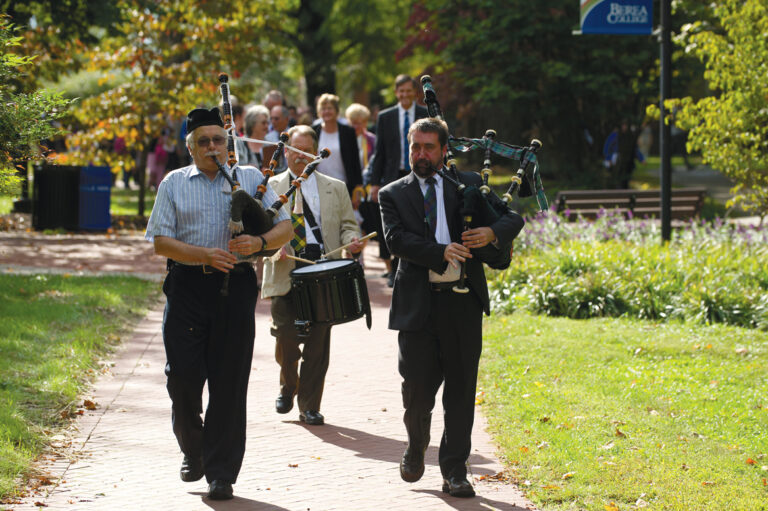Only then may I live
– John B. Stephenson,
from his poem: “Speak My Name” On October 3, 2013, the college community gathered to celebrate the tenure of Berea’s seventh president, the late John B. Stephenson, and his wife Jane, both of whom modeled lives of service to the college, the region, and the human spirit. The day was highlighted by a convocation detailing the history and accomplishments of the New Opportunity School for Women, which Jane founded in 1987, and the rededication of the Bruce-Trades Building as Stephenson Hall in honor of the former president. During the convocation, Jane spoke about her family’s time as Berea College’s first family, but she reserved the majority of time to focus on the continuing work done at the New Opportunity School, which helps improve the educational, financial, and personal circumstances of low-income, middle-aged women in Kentucky and the south central Appalachian region. In a video presentation, many former participants in the New Opportunity School described how its services transformed their lives by allowing them to develop independence-based education and self-confidence.
At the conclusion of the convocation, many in the audience moved out of Phelps Stokes and onto the quad. Led by President Lyle Roelofs, Laurie Roelofs, Jane Stephenson and Dean Chad Berry and others, the spirited group proceeded to the sidewalk in front of Bruce-Trades (soon to be dedicated Stephenson Hall) accompanied the entire way by John and Jane’s son, David Stephenson and the William Sutherland Reid Pipes and Drums.
With a snip of the ceremonial scissors held aloft by President Roelofs and the former First Lady Jane Stephenson, the Bruce-Trades Building was transformed into Stephenson Hall. Inside the Hall, Dean Berry began the Ceremony of Dedication by observing how fully John Stephenson embraced the inclusive Christian identity of the college: “he modeled for us a way of living and being that took Western ways and joined those with Eastern philosophies. In his life and work he modeled the Socratic imperative that the unexamined life is not worth living, but he also adopted the Buddhist apothegm that unlived life is not worth reflecting on.” What Mean These Stones? Reflections on the Life of John Stephenson
An Appalachian by birth, John Stephenson earned degrees from the College of William and Mary and the University of North Carolina, Chapel Hill. He earned his doctorate in sociology from the latter institution with a dissertation focusing on the struggles of an Appalachian town. From there, he built his career around the region, earning appointments as director of the Appalachian Center at the University of Kentucky, chairman of the Appalachian Studies Conference, and, shortly after founding the Kentucky Governor’s Scholar Program, president of Berea College.
During his presidency, John’s reflections on life were shared through the voice of a mouse named Arthur. No ordinary mouse, Arthur composed columns for The Pinnacle, in verse, and in lower case because capitalization required the ability to reach the shift button. One week, after a run-in with a mousetrap, he noted to “the pres” to write more poetry because “life is short and art is long.”
Longer than art, perhaps, are stones. John, as himself this time, spoke of stones during a sermon in and about Danforth Chapel. The stones in question were the very stones making up the chapel, stones from all reaches of the globe, which he referred to as “a glorious rockpile” serving to “remind us forever of the need to be soft, gentle, giving, and forgiving.” The pile of rocks that is Danforth Chapel he likened to the memorial established by the biblical Joshua upon the Israelites crossing of the River Jordan. Both were testaments to optimism and divine providence, as well as foundations for storytelling when future generations looked upon these structures and pondered to their elders: What mean these stones? (Joshua 4:21).
There is poetic justice in the rededication of the Bruce-Trades building as Stephenson Hall. The stones are bricks, produced in this instance of local earth, of the very Appalachian soil to which Stephenson devoted so much of his time and scholarship, and placed atop one another initially by Berea student hands. What mean these stones? As of October 3, 2013, they represent the long art of commemorating the life of an Appalachian visionary.
Given his focus on the betterment of Appalachia, it is fitting that the bricks now bearing his name surround the Loyal Jones Appalachian Center, where outreach and education initiatives continue to this day. As Jane Stephenson noted, it is the “perfect place” to honor him as the centers and programs housed in the building provide Berea College students “exceptional opportunities to show love for God through service to others.”


